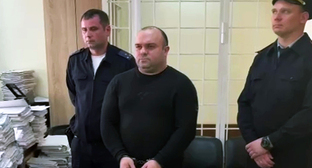19 April 2003, 03:50
The main features of the current social and economic situation in Dagestan
The modern situation in Dagestan is characterised by the crisis in all spheres of economy. During the last years the republic experiences one of the most difficult periods in the social and economic development.
Due to objective and subjective reasons related with the general unstable situation in North Caucasia and consequences of financial and economic crisis in the country, Dagestan experiences hardest economic decline. The causes of this situation were the features of the previous period of development of economy, specially the specifics of its economic structure based on defence industry and agriculture badly adapting to market conditions. Essential negative influence on economic and social life in 1995 - 1996 was produced by transport and power supply blockade caused by events in Chechnya.
Due to the above causes Dagestan that till 1991 was one of the most developed regions in North Caucasia has become a depressive and subsidised region almost wholly dependent on the federal centre. During 1991 - 1998 the volumes of industrial production were reduced by more than 80%, investments in fixed capital - by 57%. The collapse happened not only in engineering industry (in this branch due to defence industry), but also in chemical and oil producing branches where production was reduced by more than 1/3 compared with 1990. The volume of gross production in agriculture was reduced by 65%. The Russian crisis of 1998 has not left the Dagestan economy out. The slight tendency to stabilisation seen in 1997 expressed in 2% growth of the gross regional product was not further developed. Under conditions of sharp growth of inflation and aggravating crisis of non-payments tendency of decline prevails again.
According to the results of 1998 the paces of decrease of the gross regional product in Dagestan were 2.4% compared with the level of 1997. Production in industry and agriculture was decreased, the amount of non-payments has grown, foreign trade turnover of republic was considerably reduced, the budget of the republic is in critical condition. Financial difficulties hindered realisation of active state policy in the field of social protection of the population; high level of the indebtedness on wages and allowances was preserved.
In the industry by 1997 the volumes of production decreased by 7% (in the Russian Federation - by 5.2%). Production in chemical industry (-64.5%), light industry (-30%), flour-and-cereals industry and feed mill industry (-40%), electric power industry (-23%) was mostly reduced. At the same time volumes of production were kept practically at the same level in fuel branch (decline was only 0.8%), in woodworking they have grown by 24%, in building materials industry - by 5% compared with 1997. In the food industry and engineering the rate of decrease of production was the average in the whole industry: -8 and -7% respectively.
The increase of gas production (+2.7%) was observed, but at the same time production of electric power (-24.8% by 1997) decreased, oil production decreased by 2.7%. The results of work of electric power industry in 1998 were influenced negatively by shallowness of rivers. Putting into operation of the first line of Irganay hydroelectric power station with the capacity of 120 thousand kW at the end of 1998 did not improve the electrical power supply in the republic because due to low level of water in the Sulak river its operation was stopped already in the first numbers of January 1999. In engineering the production of diesel engines, metal-cutting machines, equipment for agriculture has grown, as well as production of household appliances - irons, colour television sets, which softened the general decline in the industry area. The food industry had a sharp decline observed in meat and dairy industry (-27%), fishery (-18%) that was partly compensated by the increase of production in fruit and vegetable industry (+0.6%) and production of soft drinks (+61%). For the last years the situation in meat and dairy industry has worsened considerably: the capacity of the leading meat-processing factories are used only for 7 - 10% of, since 1995 Derbent and Khasavyurt meat-processing factories do not work, since 1998 Kizliar centre is closed.
Production of consumer goods has considerably decreased in the republic because of high saturation of the market by imported consumer goods. The level of production in 1998 constituted only 1/4 (25.2%) of production volume in 1990, including food products - 16.6%, non-food products - 15.6%. During the years of reforms the production of alcohol products and beer has only increased. Activity of light industry companies was especially sharply reduced: now the republic does not have its own footwear, children's clothes, knitted wear production, etc. The agricultural production (gross) was reduced during 1998 by 8.5%. The factors influencing the reduction of agricultural production remain: deterioration of financial condition and technical support of agriculture, disparity of prices for agricultural and industrial production, underdevelopment of trade intermediary services. The situation in agriculture in 1998 was aggravated by unfavourable weather conditions. The volumes of gross production in agriculture decreased by 17.1%, in cattle breeding - by 4.4%. At the same time in private farms that were more stable during the period of reforms in Dagestan compared with the state companies the decrease in production in 1998 was only 3.9%, which is considerably less than in agricultural companies (25.9%).
In the spheres of crop production and gardening in 1998 compared with 1997 the total crops of grain (-28%), fruit (-35%), grapes (-25%) were reduced, the crops of vegetables have grown (+9%) and the gross yield of potatoes was kept at the previous level.
The situation in cattle breeding industry remains difficult. Two tendencies were observed for the last few years: decrease of production rates of meat and milk, on the one hand, and increase of rate of cattle slaughter (sale), on the other hand, which resulted in reduction of livestock. Till 1996 the decrease of livestock in public sector to some extent was compensated by its growth in private farms, however during the last years and there is the same process. The causes are advanced increase of costs on meat and dairy production compared with the increase of its cost; increased demand for meat in adjacent states; low level of zootechical service; increasing cost and deficit of mixed fodders; difficulties with the sales of production.
The investments in fixed capital were also sharply reduced. In total for the last 8 years the amount of investments in fixed capital was reduced for more than 3 times. From the total amount of used investments - 2069 million roubles (0.5% of all volume of investments used in Russia in 1998) - 46% of funds were allocated for production needs and 64% for non-production construction. The share of budget sources in financing of construction has slightly increased at the expense of the federal budget - up to 37%, but the main source of capital investments are still own funds and borrowed funds.
Despite unstable financing the republic continued to construct production and housing objects. The first hydraulic unit of Irganaisk hydroelectric power station was put into operation, the capacity of Makhachkala heat station was increased, the activities on construction of electric power lines and recovery of communication with the power system of North Caucasia were conducted.
Nevertheless, in general the decline of the investment activity is evident conditioned in many respects by reduction of the share of centralised capital investments and spasmodic receipt of funds from the federal budget. This caused termination of construction of a part of major republican objects and work of a number of programmes.
The situation in the consumer market, despite the difficult economic situation, is characterised by the growth of consumer demand and retail turnover. In 1998 more consumer goods and services were sold to the population of the republic than during the previous year for 17.6% (in comparable prices). The retail turnover has reached almost 4.4 billion roubles per year and increased by 22.8% compared with the level of 1997. The amount of sale of paid services to the population was reduced almost by 9%. The saturation of the consumer market was slightly reduced, after August 1998 some foreign food products disappeared from sale.
The Russian financial and economic crisis of 1998 has caused inflation processes in all spheres of economy. The level post-crisis inflation in Dagestan was slightly lower that average in Russia, while the growth of prices for paid services was higher. The highest rates of growth of prices were observed in consumer market - 1.8 times and in agriculture - 1.3 times. In 1998 the consumer price index was 178%, in the Russian Federation - 184.4%, including for goods - 183%, for services - 120%. In trade and agriculture the prices for meat, fruit and vegetables in Dagestan increased on the average less than in Russia. In the sphere of small business the volumes of production of goods and services increased 2 times compared with 1997, which also stabilised the consumer market.
Source: I.G. Kosikov, L.S. Kosikova. North Caucasia: Social and Economic Reference Book





Комментирование через Кавказский узел